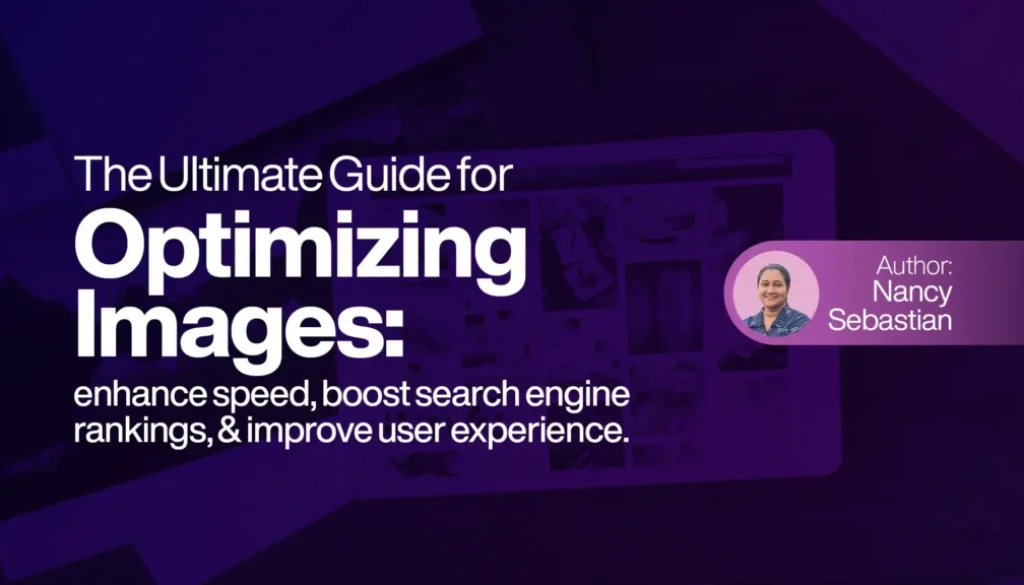The Ultimate Guide for Optimizing Images: enhance speed, boost search engine rankings, and improve user experience.
In today’s digital realm, visuals serve as more than mere aesthetics; they convey essential messages. Images used in online marketing can affect how customers think about a company and if they continue visiting their website. There’s a secret issue: poorly optimized images cause websites to run slow.
Page speed matters more than just being technical; it impacts things like bounce rates, conversion rates, search engine ranking, and brand reputation. Image optimization is now necessary because it’s crucial.
In this guide, we’ll learn about image optimization, see how important it is, and find ways to do it well
Table of Content
What is Image Optimization?
Making images smaller without looking bad or blurry is at the heart of image optimization.
This involves:
- Choosing the right file format.
- Compressing images to reduce unnecessary data.
- Resizing them to fit your website’s design.
- Serving them responsively across devices.
- Using techniques like lazy loading for efficiency.
Is there a specific goal? Images that enhance your site’s appeal without slowing it down.
Why Image Optimization?
1. Faster Website Loading Research indicates that 53% of visitors abandon websites when they take more than 3 seconds to load. Unoptimized heavy images cause slow loading speeds. Making them faster improves your website’s speed and stops people from leaving quickly.
2. SEO Benefits Google focuses on sites that provide an easy-to-use interface. Since faster loading sites rank better in searches, optimizing images helps increase their visibility. Moreover, adding detailed alternative text for images improves their visibility in Google’s image search, thereby increasing website traffic.
3. Better Conversions If you run an online store, every second matters. A study shows that if a webpage takes longer than usual to load, it could decrease sales by about 7%. Happier customers = faster page load time = more sales.
4. Improved Mobile Experience Most internet visits originate on smartphones or tablets. Images that aren’t optimized use too much internet speed, run out of power quickly, and make people unhappy when they can’t see what’s happening online. Optimizing makes web use easy on all devices.
5. Reduced Server Load and CostsFewer large files require less server space. Image optimization can save big bucks if you’re spending on bandwidth or handling heavy traffic.
Best Practices for Image Optimization
1. Select the Right Format
Each format serves a purpose:
- JPEG – Ideal for photos, vibrant hues, and subtle tones.
- PNG – Perfect for logos, making them transparent, and creating basic graphics.
- Google’s WebP format offers up to 30% smaller file sizes compared to JPEG and PNG images, maintaining visual clarity.
- An emerging AVIF format offers superior compression yet lacks widespread support.
- SVG – Perfect for icons, logos, and illustrations because it maintains quality when scaled up or down.
Rule of thumb: Use WebP or AVIF for modern browsers, fallback to JPEG/PNG where necessary.
2. Compress Images Smartly Compression reduces file size by removing redundant data.
- Lossless compression keeps quality intact (best for logos/graphics).
- Lossy compression makes images look a bit blurry but uses less space in files (. jpg format), great for pictures.
Tools you can use:
- Tiny PNG
- Image Optim
- Squoosh by Google
3. Resize Before Uploading
One mistake many people make when sharing photos is sending them as large files directly from their cameras or online stores. Don’t upload a 5000px image if you need an 1200px wide one for your blog’s layout. Resize your image first to reduce file size and enhance upload speed.
4. Use Responsive Images
Modern HTML includes the srcset attribute, enabling browsers to select the best image size for devices.
For example:img
src=’image-800. jpg’
srcset=’image-400. Image at size 400 pixels wide, picture 800 in dimensions. Image-1200 in jpg format at 800 pixels wide.
jpg 1200w’ sizes='(max-width: 600px) 400px, (max-width: 900px) 800px, 1200px’ alt=’Optimized Example Image’Mobile devices receive smaller images, whereas desktops obtain better quality ones.
5. Add Alt Text and File Names
Search engines cannot ‘see’ pictures, but they understand descriptions in the alt tags and filenames. Instead of calling it IMG_12345. Use descriptive names such as organic green tea. Jpg file.
Alt text not only boosts search engine rankings but also makes content easier for blind viewers to understand.
6. Enable Lazy Loading
With lazy loading, images appear gradually as you scroll down the page, instead of showing up instantly. This drastically improves initial page speed.
In modern HTML, it’s as simple as: src=’image.
jpg’ loading=’lazy’ alt=’Sample Image’>
7. Use a Content Delivery Network (CDN)
A content delivery network (CDN) caches and distributes your pictures among nearby servers for faster access by users. This decreases delay and quickens access globally. Cloudflare, Amazon CloudFront, and Akamai are popular Content Delivery Networks.
Tools and Plugins for Effortless Optimization
Don’t fret if you’re not a coder. Many tools simplify optimization.
- WordPress: Smush, Short Pixel, Imagify
- Shopify: Crush.pics, TinyIMG
- Magento: Image Kit, Cloud nary
- Online Tools: TinyPNG, Squoosh, Kraken.
io Automation: Cloud nary , Imgix (dynamic image optimization at scale)
Advanced Image Optimization Strategies
If you want to go beyond basics:
- Serve images in Next-Gen formats such as WebP/AVIF – modern browsers support these, and they load quicker.
- Store commonly accessed images in local storage for faster access.
- When possible, use vector graphics such as SVGs; they load quickly and can be scaled without loss in quality.
- Use Google Page Speed Insights or GT Metrix to check for image problems in your monitor’s performance tools.
Final Thoughts
Image improvement is an easy way to make websites faster, help search engines find them better, and make users happier. The advantage is that no technical expertise is required; simply employing fundamental techniques such as image resizing, compression, and selecting suitable file types will significantly improve quality.
Every moment matters now, so great-looking pictures can make your website stand out from others. Start with basic tools, then use what’s available, and keep improving by learning new methods.
Remember: beautiful images shouldn’t cost you speed.



